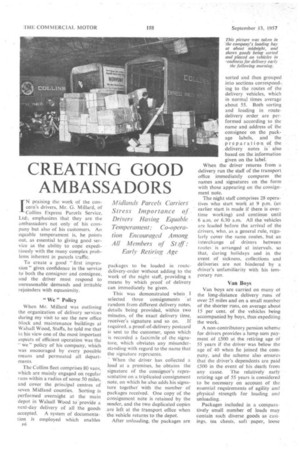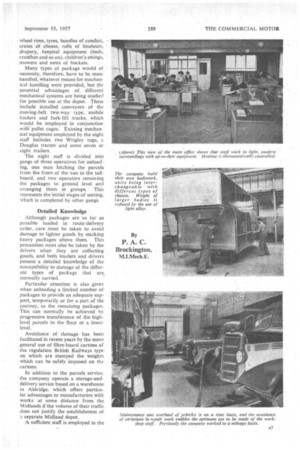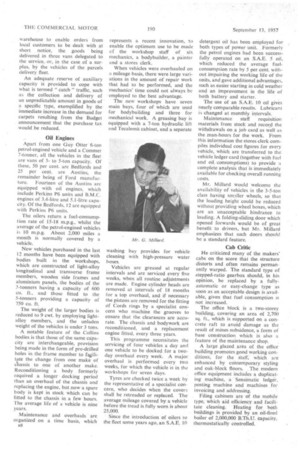CREATING GOOD AMBASSADORS
Page 40

Page 41

Page 42

If you've noticed an error in this article please click here to report it so we can fix it.
By P. A. C. Brockington, M.I.Mech.E. Midlands Parcels Carriers Stress Importance of Drivers Having Equable Temperament: Co-operation Encouraged Among All Members of St 4)(' :
Early Retiring Age
IN praising the work of the concern's drivers, Mr. G. Millard, of Collins Express Parcels Service, Ltd:, emphasizes that they are the ambassadors not only of his company but also of his customers. An equable temperament is, he points out. as essential to giving good service as the ability to cope expeditiously with the many complex problems inherent in parcels traffic.
To create a good "first impression" gives confidence in the service to both the consignor and consignee, and the driver must respond to unreasonable demands and irritable rejoinders with equanimity.
" We " Policy When Mr. Millard was outlining the organization of delivery services during my visit to see the new office block and maintenance buildings at Walsall Wood, Staffs, he told me that in his view one of the most important aspects of efficient operation was the we" policy of his company, which was encouraged by every possible means and permeated all departments.
The Collins fleet comprises 80 vans, which are mainly engaged on regular runs within a radius of some 50 miles, and cover the principal centres of seven Midland counties. Sorting • is performed overnight at the main depot in Walsall Wood to 'provide a next-day delivery of all the goods accepted. A system of documentation is employed which enables p6 packages to be loaded iii routedelivery-order without adding to the work of the night staff, providing a means by which proof of delivery can immediately be given.
This was demonstrated when. I selected three consignments at random from different delivery notes, details being provided, within two minutes, of the exact delivery time,
receiver's signature and so on. If required, a proof-of-delivery postcard is sent to the customer, upon which is recorded a facsimile of the signature, which obviates any misunderstanding with regard to the name that the signature represents.
When the driver has collected a load at a premises, he obtains the signature of the consignor's representative on a triplicated consignment note, on which he also adds his signature together' with the number of packages received. One copy of the consignment note is retained by the sender, and the two duplicated copies are left at the transport office when the vehicle returns to the depot.
After unloading, the packages are sorted and then grouped into sections correspond-, ing to the routes of the delivery vehicles, which in normal times average about 55. Both sorting and loading in routedelivery order are performed according to the name and address of the consignee on the package labels, and the preparation of the delivery notes is also based on the information given on the label..
When the driver returns from a delivery run the staff of the transport office immediately compares the names and signatures on the form with those appearing on the consignment note.
The night staff comprises 28 operatives who start work at 9 p.m. (an earlier start is made if there is overtime working) and continue until 6 a.m. or 6.30 a.m. All the vehicles are loaded before the arrival of the drivers, who, as a general rule, regularly cover the same routes, but an interchange of drivers between routes' is arranged at intervals, so that, during holidays and in the event of sickness, collections and deliveries are not hindered by a driver's unfamiliarity with his temporary run.
Van Boys Van boys are carried on many of the long-distance delivery .runs of over 25 miles and on a small number of the shorter runs, on average about 15 per cent, of the vehicles being accompanied by boys, thus expediting the work.
A non-contributory pension scheme for drivers provides a lump sum payment of 000 at the retiring age of 55 years if the driver was below the age of 40 when he joined the com:pany, and the scheme also ensures that the driver's dependents are paid £500 in the event of his death from any cause. The relatively early retiring age of 55 years is considered to be necessary on account of the essential requirements of agility and physical strength for loading and unloading.
Packages included in a comparatively small number of loads may contain such diverse goods as castings, tea chests, soft paper, loose wheel rims, tyres, bundles of conduit, crates of cheese, rolls of linoleum, drapery, hospital equipment (beds, crutches and so on), children's swings, mowers and nests of buckets.
Many types of package would of necessity, therefore, have to be manhandled, whatever means for mechanical handling were provided, but the potential advantages of different mechanical systems are being studied for possible use at the depot. These include installed conveyors of the moving-belt two-way type, mobile . loaders and fork-lift trucks, which would be employed in conjunction with palletcages. Existing mechanical equipment employed by the night staff includes two Wrigley tugs, a Douglas tractor and some seven or eight trailers.
The night staff is divided into gangs of three operatives for, unloading, one man fetching the parcels from the front of the van to the tailboard, and two operators removing the packages to ground level and arranging them in groups. This represents the initial stages of sorting, which is completed by other gang.
Detailed Knowledge
Although packages are so far as possible loaded in route-delivery order, care must be taken to avoid damage to lighter goods by stacking heavy packages above them. This precaution must also be taken by the drivers when they are collecting goods, and both loaders and drivers possess a detailed knowledge of the susceptibility to damage of the different types of package that are normally carried.
Particular attention is also given when unloading a limited number of packages to provide an adequate support, temporarily or for a part of the journey, to the remaining packages. This can normally be achieved by progressive transference of the highlevel parcels to the floor or a lower level.
Avoidance of damage has been facilitated in recent years by the more general use of fibre-board cartons of the regulation British Railways type on which are stamped the weights which can be safely imposed on the cartons.
In addition to the parcels service. the company. operate a storage-anddelivery service based on a warehouse in Aldridge, which offers particular advantages to manufacturers with works at some distance from the Midlands if the volume of their traffic does not justify the establishment of a separate Midland depot.
A sufficient staff is employed in the warehouse to enable orders from local customers to be dealt with at short notice, the goods being delivered in three vans delegated to the service, or, in the case of a surplus, by the vehicles of the parcels delivery fleet.
An adequate reserve of auxiliary capacity is provided to cope with what is termed " catch " traffic, such as the collection and delivery of an unpredictable amount in goods of a specific type, exemplified by the immediate increase in the demand for carpets resulting from the Budget announcement that the purchase tax would be reduced.
Oil Engines
Apart from one Guy Otter 6-ton petrol-engined vehicle and a Commer 7-tonner, all the vehicles in the fleet are vans of 3to 5-ton capacity. Of these, 50 per cent are Bedfords and 25 per cent. are Austins, the remainder being of Ford manufac ture. Fourteen of the Austins are equipped with oil engines, which include Perkins P6 units and B.M.C. engines of 3.4-litre and 5.1-litre capacity. Of the Bedfords, 12 are equipped with Perkins P6 units.
The oilers return a fuel-consumption rate of 15-18 m.p.g., whilst the average of the petrol-engined vehicles i. 10 m.p.g. About 2,000 miles a month is normally covered by a vehicle.
New vehicles purchased in the last 12 months have been equipped with bodies built in the workshops, which are constructed of light-alloy longitudinal and transverse frame members, wooden side frames and aluminium panels, the bodies of the 3-tonners having a capacity of 600 cu. ft., and those fitted to the 5-tonners providing a capacity of 750 cu. ft.
The weight of the larger bodies is reduced to 9 cwt. by employing lightalloy members, and the unladen weight of the vehicles is under 3 tons.
A notable feature of the Collins bodies is that those of the same capacity are interchangeable, provision being made in the form of pre-drilled holes in the frame member to filitate the change from one make of Chassis to one of another make. Reconditioning a body formerly required a longer docking period than an overhaul of the chassis and replacing the engine, but now a spare body is kept in stock which can be fitted to the chassis in a few hours. The average life of a vehicle is nine years.
Maintenance and overhauls are organized on a time basis, which a8
represents a recent innovation, -to enable the optimum use to be made of the workshop staff of six mechanics, a bodybuilder, a painter and a stores clerk.
When vehicles were overhauled on a mileage basis, there were large variations in the amount of repair work that had to be performed, and the mechanics' time could not always be employed to the best advantage.
The new workshops have seven main bays, four of which are used for bodybuilding and three for mechanical work. A greasing bay is equipped with a 7-ton hydraulic lift and Tecalemit cabinet, and a separate washing bay provides for vehicle cleaning with high-pressure water hoses.
Vehicles are greased at regular intervals and are serviced every five weeks, when all routine adjustments are made. Engine cylinder heads are removed at intervals of 18 months for a top overhaul, and if necessary the pistons are removed for the fitting of Cords rings by a specialist concern who machine the grooves to ensure that the clearances are accurate. The chassis and bodywork are reconditioned, and a replacement engine fitted, every three years.
This programme necessitates the servicing of four vehicles a day and one vehicle to be docked for a twoday overhaul every week. A major overhaul is performed every two weeks, for which the vehicle is in the workshops for seven days.
Tyres are checked twice a week by the representative of a specialist concern, who decides when the covers shall be retreaded or replaced. The average mileage covered by a vehicle before the tread is fully worn is about 25,000.
Since the introduction of oilers to the fleet some years ago, an S.A.E. 10 detergent oil has been employed for both types of power unit. Formerly the petrol engines had been successfully operated on an S.A.E. 5 oil, which reduced the average fuelconsumption rate by 5 per cent. without impairing the working life of the units, and gave additional advantages, such as easier starting in cold weather and an improvement in the life of both battery and starter.
The use of an S.A.E. 10 oil gives nearly comparable results. Lubricant is changed at monthly intervals.
Maintenance staff requisition materials from stock and record the withdrawals on a job card as well as the man-hours for the work. From this information the stores clerk compiles individual cost figures for every vehicle, which are transferred to the vehicle ledger card (together with fuel and oil consumptions) to provide a complete analysis that is immediately available for checking overall running costs.
Mr. Millard would welcome the availability of vehicles in the 3-5-ton class having smaller wheels, so that the loading height could be reduced without providing wheel boxes, which are an unacceptable hindrance to loading. A folding-sliding door which opened forwards would be of great benefit to drivers, but Mr. Millard emphasizes that such doors should be a standard feature.
Cab Critic
He criticized many of the makers' cabs on the score that the structure distorts and often remains permanently warped. The standard type of stepped-ratio gearbox should, in his opinion, be replaced by a fullyautomatic or easy-change type as soon as an acceptable design is available, given that fuel consumption is not increased.
The office block is a two-storey building, covering an area of 2,700 sq. ft., which is supported on a concrete raft to avoid damage as the result of mines subsidence, a form of base construction which is also a feature of the maintenance shop. .
A large glazed area of the office building promotes good working conditions; for the staff; which are enhanced by contemporary styling and oak-block floors. The modern office equipment includes a duplicating machine, a Sensimatic ledger. posting machine and machines for invoicing and addressing.
Filing cabinets are of the mobile type, which aid efficiency and facilitate cleaning. Heating for both buildings is provided by an oil-fired boiler of 2,000,000 B.Th.U. capacity, thermostatically controlled.




























































































